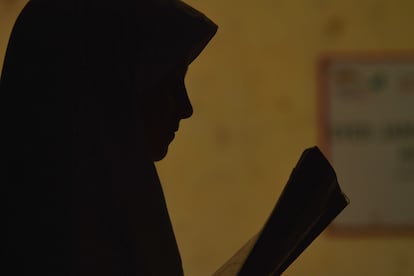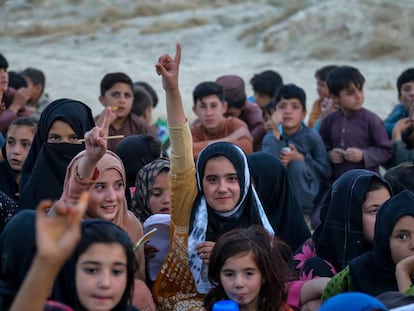Journalism without women in Afghanistan: “Stopping the work of female reporters is another form of violence against us”
After the return of the Taliban to power in 2021, the female presence in the media has practically disappeared. Working from exile, at home or secretly are the options for those who do not want to abandon the profession

Threats have followed Baran* for the six years she’s worked in the media. But the challenges of working under Taliban rule have made the job almost impossible. Most female journalists have either stopped working or left the country altogether.
Baran, 24, says the situation is “unbearable” with female journalists facing blanket “gender discrimination” and “misogyny” from the de facto authorities.
“Male journalists are members of social media groups with the officials from the local Taliban office, and they only cooperate with the men in most cases,” she says.
“But because we are women and we do not have a letter from the governor’s office, the officials do not want to meet and interview us, and even don’t answer our calls.”
The Kabul University graduate has worked for both foreign and local outlets, travelling to various locations for her work. But Taliban-imposed restrictions on women’s movement have impacted the possibility of continuing this practice.
“I need to do interviews and video reports. For that, I must be in the community and among the people and go to remote areas, but I cannot freely go to the districts or remote areas,” Baran says.
Baran says her husband was detained by Taliban forces in the local police district and he was interrogated about her work, before he was made to sign a letter of commitment.
“They called my husband to the police district and said that the reports I had made during the Republic government were not acceptable to them, and they made him promise I would not make any more reports against the Taliban government,” she says.
Female journalists in the western region of Afghanistan say that Taliban’s Vice and Virtue department visit media offices at least once a month to check women are wearing clothed is according to their standards and that men and women colleagues are separated.
Samira* has been working as a reporter for four years since a media internship in the eleventh grade with a local media outlet.
She says that the arrival of the Taliban has drastically altered women’s representation in the media and female journalists face a “dark future”.
“In the last two years, the presence of women in the media has decreased and the presence of reporters, presenters and anchors in the local media has decreased, but the female reporters who have accepted the difficulties and continued their work are also afraid to encounter the detention for publishing news that is against the Taliban’s ideology,” she says.
Samira goes to her office wearing a namaz chadar or all-covering hijab to adhere to the Taliban officials who come to her office to examine how women are dressed.
She says that most women journalists are not able to conduct field reports, and those who still work feel safer continuing their journalism from their homes.
Like 22-year-old Nasima*, who is still one of the few women hosting a radio program in the western region.
Due to the travel and segregation restrictions on women, she records her program at home every week and sends it to the local radio station for broadcast.
She is not allowed to have male guests for interviews. Furthermore, she says female journalists are also not allowed to participate in conferences, programs of Taliban members, and press meetings of the Taliban’s Vice and Virtue employees with media officials.
Muzhda*, a journalism graduate from Herat University says some of the journalists prefer not to reveal their profession to the de facto authorities.
“There are restrictions for female reporters, anchors and presenters, and female reporters who work with foreign media are afraid of being arrested and imprisoned by the Taliban. Some don’t even get a journalist’s card from the Department of Information and Culture, so they work as journalists secretly, and most of their work is not in the field,” Muzhda says.
These restrictions also result in further discrimination from employers, she says.
“The media officials take advantage of the current situation and when hiring, they prefer male reporters. If they hire female employees, they will be hired with a much lower salary than men.”
Muzhda has attempted to cover meetings of Taliban officials with her male media colleagues, but says she is stopped at the entrance gate and not allowed to enter.
Within months of taking control of Afghanistan, the Taliban began cracking down on women in the media.
In November 2021, the group released an eight-article instruction that banned women from acting in plays and television series. Afghan media chiefs were directed not to broadcast anything against Islamic Sharia, a far-reaching directive that would include foreign television shows and music. And female news presenters were required to wear face coverings.
Parwana, 25, worked for four years as an anchor and reporter in one of the local radio stations in Farah province. After the collapse of the Afghan government in 2021, she became home-bound.
“Farah province is a remote province with a very traditional values. Before the fall of Afghanistan to the Taliban, security threats were the obstacle for women journalists, but during the last two years, women’s media activities in Farah have stopped and no women or girls are working in the media’s anchoring and reporting departments.”
Parwana suspended her work in Farah for a while when the Taliban took power out of concern for her safety, but she wants to return to work when the situation improves.
“I stayed at home because women were not allowed to work in the media. Not only me, but most of the women journalists in this province are unemployed and are facing mental and emotional problems,” she says.
But like dozens of other female journalists, Parwana does not see herself returning to work as a journalist during Taliban rule and has started studying midwifery in one of the institutes.
“I made a lot of effort in the media sector, but due to this situation, all my goals and dreams were lost,” she says.
Sohaila Erfani, a professor at Journalism and Mass Communication at Herat University, says that during the republic, Herat province was a pioneer in the field of teaching journalistic skills to the young generation, which included students from most parts of the country.
Herat Journalism Faculty started in 2011 with two departments of Journalism and Public Communication, and before that operated as the Department of Literature and Human Resources from 2002-2011.
Ms Erfani says before the Taliban takeover, girls’ interest in working in the media had grown significantly and they soon made up about half of the students every year.
She is dismayed at the decimation of women in the media.
“A female journalist can better communicate with her gender and express her pain and write from her point of view, but with the imposition of restrictions, the voices of all women have been silenced,” she says.
According to Rukhshana Media’s investigation, before the Taliban takeover there were at least 100 women working in the media in Herat province and at least 60 more women media workers in other western provinces of Farah, Badghis, Nimroz, and Ghor.
Today it is unclear how many are still working.
Atifa Ghafoori, former head of the women’s department of the Committee for the Protection of Journalists in Afghanistan’s West Zone, says that the significant decrease in the activity of women in reporting and media activities indicates a fundamental crisis in this field.
“A female journalist has felt the problems of women with flesh, skin, and bones and has raised their voices to women’s rights organizations and the world,” she says.
“In the last 20 years, women journalists have been successful in fighting violence, but stopping the work of women journalists alone is a form of violence against women.”
The people interviewed for this report did not want to disclose the province where they work.
Sign up for our weekly newsletter to get more English-language news coverage from EL PAÍS USA Edition









































